 Let’s have a look at the European fashion at the beginning of the 17th century. During the Early Baroque era, the male costumes were much more ornate and decorative than female ones. Though, this period is pretty nice and comfortable because people didn’t fall to the extreme ends – women’s clothing was feminine and flowing, while men’s outfits looked comparatively masculine, though they were richly embellished. But you’ll see what I mean on examples.
Let’s have a look at the European fashion at the beginning of the 17th century. During the Early Baroque era, the male costumes were much more ornate and decorative than female ones. Though, this period is pretty nice and comfortable because people didn’t fall to the extreme ends – women’s clothing was feminine and flowing, while men’s outfits looked comparatively masculine, though they were richly embellished. But you’ll see what I mean on examples.
The article is based on a video by Amanda Hallay, fashion historian
Men
Let's start off with men. This was the look across the courts and nobility of Europe, and a less fancy style applied to a less grandiose people.
On the left, there’s a painting of two gentlemen from the 1600s. And on the right, is a surviving outfit from the 1630s.
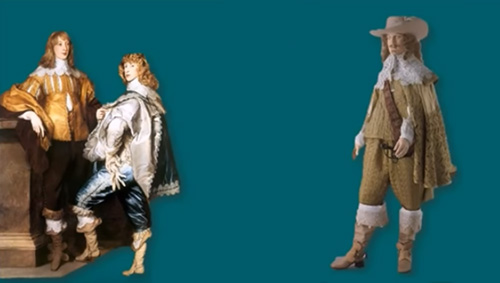
In this picture, you can see something called a “falling band”. This was a wide, flat collar worn by both men and women; it could be simple linen, it could be trimmed with lace, or it could be entirely made of lace.
The next garment is a doublet. And it's really changed with time. Doublets in the 17th century have a very high waistline and a loose, flared fit. Buttons or hooks & eyes replace laces. Sleeves are billowy. So, it's a much looser kind of silhouette than was used before.
Next – capes. The capes often matched both doublet and breeches.
And breeches. The hose has gone, although men still wore underhose. And these breeches were secured to the doublet with hooks.
Finally, boots. Boots had heels, they were kind of loose and had a funnel-shaped opening at the top and so-called “latchets” (decorative leather straps) over the instep.
The hair was shoulder-length, flowing, and real – no wigs yet. By the way, long, flowing real hair would play a huge political role in the 1600s.
Hats were wide-brimmed and usually adorned with buckles and feathers.
Around the waist of the men from 1630s, there's a baldric. A baldric was a thick leather belt. Later on in the 1600s, baldrics would be made of silk or satin, more like a sash. And a baldric was worn around the body, and a sword was attached to it.
Also, you can see cannons on him. These were lace or ruffs, attached to the top of the hose or the bottom of the breeches.
But one of the most popular garments – it was worn by the military, by people who lived in the country, it was worn when men went riding, it was like an everyday kind of garment – was a buff coat. It was extremely popular; it had either long or short sleeves, and it was made out of buckskin (deerskin).
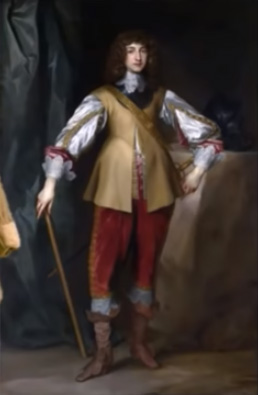
Here is a portrait of a man with all of these elements, including a buff coat. His – is short-sleeved. He also has those boots with the funnelled top, and latchets, and the lace cuffs, and the falling band, and the flowing hair, and the baldric.
Male attire was more adorned than female attire in the 1600s.
Women
Let's take a look at female attire in the first half of the 17th century.
You're going to see a far softer silhouette. And by the way, the fashionable women’s figure of the period is a little bit chubby body that comes from the painter Rubens. So this body shape is called “rubenesque”. It's sort of a nice way of saying, a little bit chubby or pleasantly rounded. And, of course, the clothing styles depended on the figure of that era’s women.
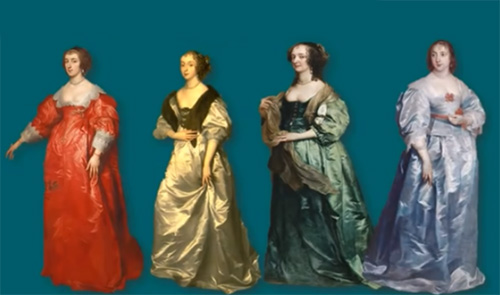
The attire would start off with a shift. This is a simple linen underdress, the underwear.
Over it, went a bodice.
Then, a separate underskirt, over which went something called an “overskirt”, but it goes all the way up to the top.
Next, a stomacher and lace sleeves.
If to talk about the fabrics of the gowns, taffeta and lace replace the brocade and velvet of the earlier century for wealthy and fashionable women.
The costume has a lace standing collar, but way at the back. Soon, it would be replaced by a falling collar.
Of course, women wore jewelry. A string of pearls that was put quite high on the neck and pearl earrings.
Hair was center-parted, quite full at the sides with ringlets.
And female hats sort of imitated men's hats.
So, the silhouette was sloping, with rounded shoulders and a high waistline.
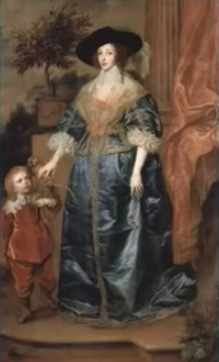
Later, the stomacher started to be incorporated into the dress thanks to new technologies in hooks & eyes. With hooks, you can get the top part of your bodice tight enough without having to lace a stomach in. It doesn’t mean that lacing was forgotten – it came in and out as the century progressed.
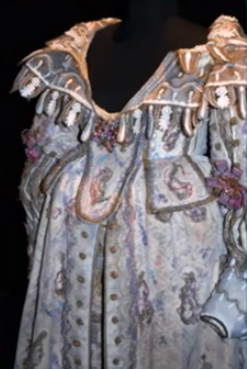
In this picture of a very fancy gown, you can see these purple sort of flowers. This was a very popular trim throughout the 1600s. It's called a “rosette”. It's actually a ribbon formed to look like a little flower.
(c)


